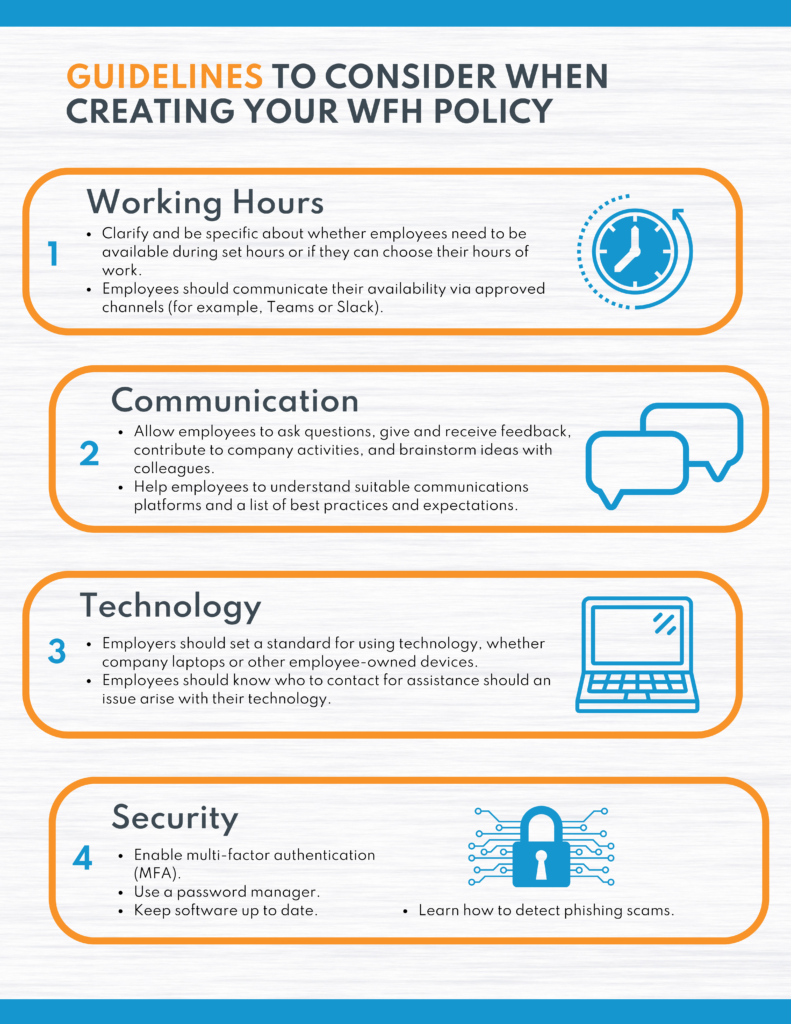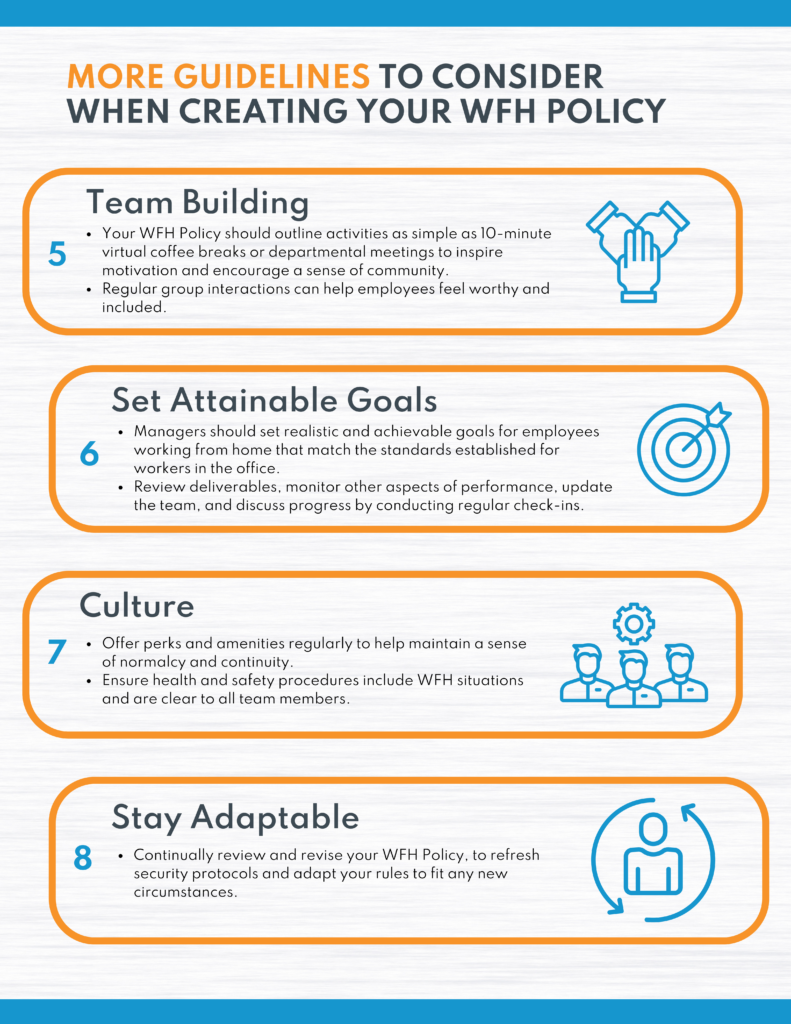Having a Work from Home (WFH) Policy has become a fixture in our modern world. WFH became predominant during the global pandemic of 2020 and continues to be a popular option for many. It has allowed workers to part ways with long commutes and the need to be in an office setting. Moreover, various organizations have had the opportunity to collect data on the remote working model. Here are some stats about remote work from Statista.com and the PWC Canadian Office Worker Survey 2021:
- In March 2021, around five million Canadian employees were working remotely. This accounts for over 30% of Canadian workers.
- 41% of Canadian employees say their productivity increased while working from home.
- 81% of employers and 78% of employees agree their organization has the necessary tools and technologies to be successful in their jobs when working remotely.
More Stats
In one survey conducted by the Future Skills Centre, the Environics Institute for Survey Research, and the Diversity Institute at Toronto Metropolitan University’s Ted Rogers School of Management, 78% of Canadian employees say they prefer working from home to their regular workplace. Though workers still face some significant challenges while working remotely. This includes dealing with mental health issues, staying motivated, and communicating and feeling connected to their team.
Still, according to recent research at Harvard Business School, many employers recognize the benefits overall of working remotely. This includes boosted productivity, reduced turnover, and lower organizational costs. Altogether, employees and employers enjoy perks like having more time, fewer distractions, and more schedule flexibility.
With all these pros and cons, creating a Work from Home (WFH) Policy that clearly outlines the standards for working remotely (for employees and employers approving or choosing to work from home) is essential. In addition, as remote work becomes increasingly favoured, the security risks to employees and businesses increase. To learn more about this, check out our blog post – Remote Working Security Risks & Tips
Creating a Work from Home Policy
To start, make sure your Work from Home Policy covers the following basic security practices:
- Clearly define which positions are eligible for WFH.
- List the approved tools and platforms for use.
- Provide employees with steps to follow at the first signs of an account compromise.
- Provide employees with training to help them recognize the risks and know what to do when cyberincidents occur.
Here are some additional guidelines to consider when creating your Work from Home Policy:
1 – Working Hours
Virtual hours may differ from traditional office hours. It is vital to clarify and be specific about whether employees need to be available during set hours. Alternatively, they can choose their hours of work. Employees should communicate their availability via approved channels (for example, Teams or Slack).


2 – Communication
Maintaining effective online conversations is important. Allow employees to ask questions, give and receive feedback, contribute to company activities, and brainstorm ideas with colleagues—all entirely from a virtual setting.
Having well-defined communication guidelines outlines how and when staff should communicate. It is also crucial for employees to understand suitable communications platforms. In addition, they should be provided with a list of best practices and expectations, for example, the timeline to respond to an email or answer instant messages.
3 – Technology
Employers should set a standard for using technology. Company laptops or other employee-owned devices may be used. Of course, employees should use their work laptops strictly for work purposes. Employees should know who to contact for assistance should an issue arise with their technology. Partnering with an IT provider like Clearbridge can help you manage your WFH Policy from a technology and security standpoint.
4 – Security
As we have reviewed in our blog post, Remote Working Security Risks and Tips, cybersecurity is a significant concern in virtual work-from-home settings. Your WFH Policy should include preventative measures and proactive steps that the entire organization can follow to stay secure.
Here are a few security best practices for your Work from Home Policy which you can implement today:
- Enable multi-factor authentication (MFA): MFA provides an additional layer of security. The more security layers in place, the harder it is for cybercriminals to access your information. Read more about MFA here.
- Use a password manager: These tools organize and protect your passwords and encourage stronger unique passwords. Password managers require a complex password. They also may require MFA to access your password list. Learn more about creating secure passwords here.
- Keep software up to date: install the latest software as soon as possible, as updates help patch security flaws and safeguard your computer. Learn more about the 7 Best Practices for IT You Need to Know here.
- Learn how to detect phishing scams: understand the key signs of a phishing email, and always be vigilant! Watch our video on how to recognize a phishing email here.


5 – Be Equal
While the WFH environment for each person is unique, there should be some ground rules regarding policies and regulations. Productivity and the quality of work should be uniform, whether from a remote worker or someone working in the office. All team members should be accountable.
6 – Home and Work Life Boundaries
It is in the best interest of everyone to separate their work environment from home life. For example, you might have time to wash the dishes between meetings, but taking on these home-life responsibilities can interfere with work tasks and impact your overall productivity. So, set some boundaries and ensure your WFH Policy outlines how employees can best meet company standards. Over time this can help prevent overworking, which can lead to burnout.
7 – Team Building
Sometimes remote work can make employees feel disjointed from the rest of the team, leading to feelings of isolation that can impact performance and job satisfaction. Your WFH Policy should outline activities as simple as 10-minute virtual coffee breaks or departmental meetings to inspire motivation and encourage a sense of community. Regular group interactions can help employees feel worthy and included.


8 – Set Attainable Goals
Maintaining a work-life balance and juggling personal responsibilities while working from home can be difficult. Managers should set realistic and achievable goals for employees working from home that match the standards established for workers in the office. In both situations, the business should continue as usual – review deliverables, monitor other aspects of performance, update the team, and discuss progress by conducting regular check-ins.
9 – Culture
If employees decide (or are assigned to) WFH, it is imperative to continue to offer perks and amenities regularly to help maintain a sense of normalcy and continuity. Involve your existing culture around your WFH Policy—for example, ensure health and safety procedures include WFH situations and are clear to all team members.
Some things to consider to help elevate your WFH culture include:
- Treat your employees with trust and respect – rather than over-monitoring your remote team, encourage your team to share their work schedules and stay in touch with their progress.
- Promote transparency – be clear about how your vision, mission, values, objectives, and purpose impact the everyday experience for your employees; this will ensure employees remain invested in their work and the company.
- Pay attention to employee mental wellness – remote workers might be dealing with personal issues, missing the old workplace and their co-workers, or generally be concerned with their job and the state of the economy. Reinforce a supportive and collaborative environment that will help workers feel engaged, connected, and uplifted while working from home.


10 – Stay Adaptable
As we all know, technology is constantly evolving. Not to mention, changes continuously impact how we approach life from a work standpoint. You should continually review and revise your WFH Policy, to refresh security protocols and adapt your rules to fit any new circumstances.
While working from home is still considered a relatively new concept, there is no denying that it is becoming more widespread and can help organizations remain competitive while achieving better results.
Finally, make sure your WFH Policy covers the following:
Policy Brief and Purpose
- What is the intent of your WFH Policy?
- What do you want to achieve by providing your employees with the opportunity to WFH?
- Communicate the importance of the WFH Policy and the implementation process.
Scope and Eligibility
- What positions specifically are available for remote work?
- How will applications to WFH be assessed?
- Are there any security or privacy issues?
- Will communication with remote employees be difficult?
- Do they have the required software or equipment installed at home?
- What are the conditions in the environment of the remote worker?
WFH can be exciting, empowering, and profitable. However, employers and employees must clearly understand expectations. With the added freedom, and ability to better plan your day, remote workers can become more self-disciplined and focused, leading to uninterrupted performance. How do you feel about working from home, and did this blog help you understand the requirements of planning a Work From Home Policy?








Download a PDF of our Work from Home Policy resource here.
If you have any questions, feel free to contact us anytime!
RELATED BLOG POSTS


7 Best Practices for IT You Need to Know
IT is easy to manage when you’re a business of one. But as your business grows and evolves, things get harder. Keep these seven best practices in mind when it comes to navigating IT for your business and you’re going to be in a better place!


What the Best Customer Service Is Really About
As IT professionals, customer service matters. We are not just maintaining networks and devices. We are focused on the people that help us do our best work (our staff) for the people we’re here to help do their best work (our customers).


How to Recognize a Cyberattack
We always want to focus on proactive cybersecurity measures, but just as important is how to recognize a cyberattack while it’s occurring! That’s why we’re covering 5 areas of your business that could be compromised and the key signs you should look out for!

